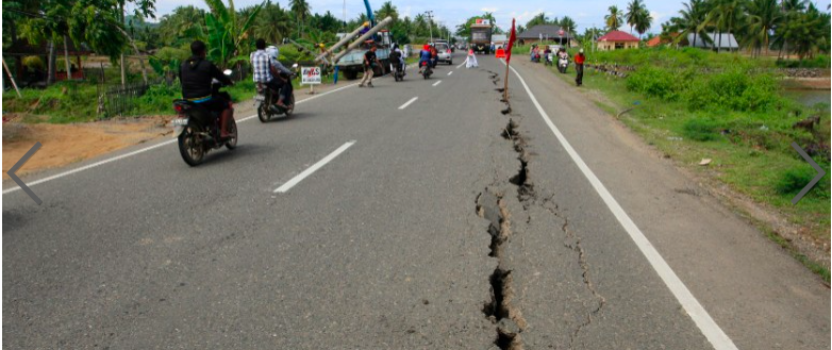Two Quakes, Different Responses
| By Ennio V. Picucci |
In December 2016, twelve years after the 2004 Indian Ocean earthquake and tsunami, Aceh was once again struck by an earthquake. However, over the past decade the landscape of responders has evolved and changed and there is need for better understanding of new actors to strengthen coordination during disasters.
Commentary
On 7 DECEMBER 2016, at 5:03 a.m. local time, a 6.5 magnitude earthquake struck the province of Aceh, Indonesia. According to the Meteorology, Climatology and Geophysics Agency (BMKG) the epicentre of the earthquake was on land, making the chance of a tsunami impossible but resulting in stronger impact on buildings in the area.
According to a spokesperson from the National Agency for Disaster Management (BNPB), over 100 buildings including shops, mosques and schools collapsed and thousands of houses were partly damaged by the quake. After weeks of search and rescue operations, the official number of people killed is 103, with hundreds of injured and over 88,000 displaced.
Actors Involved in Humanitarian Assistance and Disaster Relief (HADR)
The earthquake triggered the response of a wide range of actors. The coordination of response and assessment activities was led by the National Agency for Disaster Management (BNPB) and the Regional Disaster Management Agency (BPBD). The Indonesian military immediately deployed over 700 personnel including health and logistics experts. The Indonesia Red Cross (PMI) mobilised their emergency response teams and distributed blankets, tarpaulins, body bags, family kits and hygiene kits.
PMI set up three accounts for raising funds and put its blood transfusion unit on standby in case blood stock would be needed. International organisations such as CARE and the International Organisation for Migration (IOM) sent their assessment teams to the affected areas and assisted in the search and rescue of survivors stuck under the rubble of collapsed buildings.
Other governmental and non-governmental agencies involved in the response included the National Search and Rescue Agency (BASARNAS), Indonesian National Police (POLRI), Disaster Victims Identification team (DVI), Handicap International and the IFRC Country Cluster Support Team (CCST).
Search and rescue operations proceeded day and night but were complicated due to power outages and rain fall. In response to the blackouts, the State Electricity Company (Perusahaan Listrik Negara) deployed 20 of their personnel to the disaster zone to check the electrical conditions in the area. Heavy machinery was deployed to access people stuck under debris.
According to ASEAN’s AHA centre, a total of 181 governmental and non- governmental agencies were involved in the response activities in Aceh. Singapore and other countries stood ready to provide assistance if needed. With such myriad responders it is all the more important to sort out who offers what assistance.
Changing HADR Landscape in South-East Asia
In the recent response, the range of actors involved in HADR was significantly different compared to the 2004 Indian Ocean earthquake and tsunami response. The earthquake of 2004 caused an enormous tsunami that affected several countries and triggered an immense international response including militaries of dozens of nations, as well as United Nations agencies, (international) NGOs and private corporations.
During the 2016 Aceh earthquake, UN agencies did not play a leading role in the coordination of HADR and no foreign troops were involved in aid delivery. The main reason for this is that the disaster was of a much smaller magnitude and therefore did not require such a large-scale international response. Also Indonesia and other countries in Asia-Pacific have strengthened their disaster management systems significantly.
After the Indian Ocean earthquake and tsunami of 2004, many new NGOs and government agencies were formed in response and to deal with future disasters. Over the years for example, ASEAN has grown in importance as best illustrated by the establishment in 2011 of the ASEAN Coordinating Centre for Humanitarian Assistance on Disaster Management (AHA Centre).
To date, some of the organisations that emerged in the aftermath of the 2004 earthquake and tsunami do not exist anymore or have transformed, accompanied by plenty of newer actors. Indonesia’s BNPB which led the response efforts during the 2016 earthquake, was established in 2008 to replace a previous government institution. Also the relatively new AHA Centre aims to become the main regional coordinator in HADR. Especially at the grassroots level, the landscape of actors is very dynamic and constantly changing.
Dynamic, But A Challenge to Coordination
This dynamism represents a challenge to the coordination of disaster response. Effective coordination is therefore important to create synergies and avoid the overlapping of aid. When as many as 181 organisations are involved in the response efforts after a disaster there is a high chance that aid is duplicated in some places and under-resourced in others. This is particularly challenging as many are new and not well known to the coordinating agencies. This proliferation is expected to continue for the foreseeable future. This represents a challenge but also an opportunity to close gaps in HADR work across the Asia-Pacific and beyond.
For the near term, there is a need to map current and emerging actors involved in HADR to find out who they are and how they can work together to strengthen coordination mechanisms. The importance of strengthening coordination in HADR is highlighted by the 2016 One ASEAN, One Response declaration.
Events such as the most recent earthquake in Aceh accentuate the importance of knowing who’s who to identify quality leadership and synergies among them. The growing importance of ASEAN and the leadership potential of its AHA Centre bear great promise for a more unified approach to Humanitarian Assistance and Disaster Relief in order to strengthen disaster risk governance in the Asia-Pacific.
(This article was contributed by the author and originally posted on the RSIS commentary. Photo credit: edition.cnn.com/2016/12/06)

